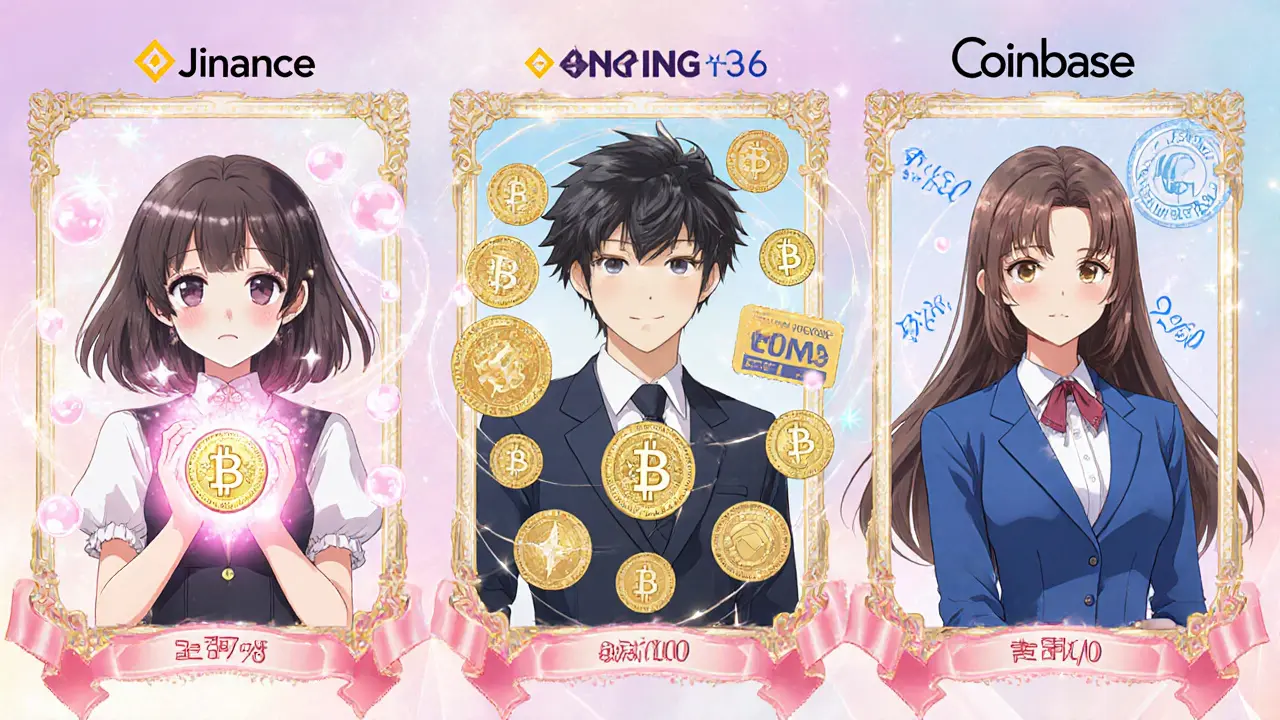Jinance Fee Calculator
Fee Calculation Tool
Estimate your trading fees on Jinance based on your trading volume and JNC holdings.
Your Estimated Fees
Fee Comparison Table
| Feature | Jinance | Binance | Coinbase |
|---|---|---|---|
| Supported assets | 250+ | 600+ | 235 |
| Maker fee (no token) | 0.15% | 0.00%-0.10% | 0.00%-0.50% |
| Taker fee (no token) | 0.20% | 0.04%-0.60% | 0.50%-3.99% |
| Fee discount with native token | Up to 0.08% / 0.13% with JNC | Up to 25% with BNB | None |
| Margin & futures | 5× margin, no futures | 125× margin, futures, options | None |
| Staking options | 12 coins, up to 12% APY | 26 coins, up to 15% APY | 7 coins, up to 6% APY |
| Cold-wallet coverage | 96% | 95%+ | 94% |
If you’ve been hunting for a crypto exchange that blends low fees with a solid security backbone, you’ve probably stumbled across Jinance review searches. Below we break down what Jinance actually offers, where it shines, and where it lags behind the biggest players in 2025.
Quick Takeaways
- Jinance supports 250+ crypto assets, including major pairs like Bitcoin and Ethereum.
- Spot trading fees start at 0.15% for makers and 0.20% for takers; discounts rise to 0.08% with the native JNC token.
- Security includes cold‑wallet storage for 96% of funds, mandatory 2FA, and real‑time AI fraud monitoring.
- Mobile and web UI are clean, but advanced tools (margin, futures) are limited compared to Binance.
- Best for traders who want a straightforward platform with decent staking options, but not for high‑frequency futures traders.
What Is Jinance?
Jinance is a centrally operated cryptocurrency exchange launched in 2021 that targets retail traders in Asia‑Pacific and emerging markets. It offers spot trading, basic margin, staking, and a small suite of DeFi products. Headquartered in Singapore, Jinance holds a virtual assets service provider (VASP) licence in the country and complies with AML/KYC regulations in the jurisdictions it serves.
Core Features
- Spot Trading: Over 250 trading pairs, deep liquidity on BTC/USDT, ETH/USDT, and BNB/USDT.
- Margin Trading: Up to 5× leverage on select major pairs; no futures contracts.
- Staking & Earn: Supports staking for 12 coins, yields ranging from 3% to 12% APY.
- Native Token - JNC: Used to pay fees, unlock higher discount tiers, and access exclusive staking pools.
- Mobile App: Android & iOS apps mirror web functionality, including charting and order types.
Fees and Limits
Jinance follows a maker‑taker model. Without JNC, the baseline is 0.15% (maker) / 0.20% (taker). Holding at least 5,000 JNC drops fees to 0.12% / 0.17%, and a 10,000JNC stake gives the lowest tier of 0.08% / 0.13%.
Deposits are free for most fiat gateways (bank transfer, local ACH in supported countries). Withdrawal fees are flat: 0.0005BTC, 0.005ETH, or 1% of the withdrawn token’s market value for less‑common assets.

Security Measures
Jinance stores the majority of user assets in cold wallets, keeping 96% offline. The remaining 4% sits in hot wallets for instant withdrawals, protected by multi‑signature controls.
Two‑factor authentication (2FA) is mandatory for withdrawals and can be set up via SMS or Google Authenticator. An AI‑driven risk engine scans login patterns and flags unusual activity, prompting a temporary freeze and manual review.
In a 2024 penetration test by a reputable security firm, Jinance’s API endpoints showed no critical vulnerabilities, and the platform’s bug‑bounty program has paid out over $750,000 since inception.
User Experience
The web dashboard uses a dark‑mode default with a collapsible left‑hand menu. Order entry panels support market, limit, and stop‑limit orders, while the charting widget integrates TradingView’s library for real‑time analysis.
Mobile users report a smooth experience; the app’s load time averages under two seconds on a 4G connection. However, traders looking for advanced order types (iceberg, TWAP) will find the offering sparse.
How Jinance Stacks Up Against the Big Guys
Below is a side‑by‑side snapshot of Jinance, Binance, and Coinbase as of October2025.
| Feature | Jinance | Binance | Coinbase |
|---|---|---|---|
| Supported assets | 250+ | 600+ | 235 |
| Maker fee (no token) | 0.15% | 0.00%‑0.10% | 0.00%‑0.50% |
| Taker fee (no token) | 0.20% | 0.04%‑0.60% | 0.50%‑3.99% |
| Fee discount with native token | Up to 0.08% / 0.13% with JNC | Up to 25% with BNB | None |
| Margin & futures | 5× margin, no futures | 125× margin, futures, options | None |
| Staking options | 12 coins, up to 12% APY | 26 coins, up to 15% APY | 7 coins, up to 6% APY |
| Cold‑wallet coverage | 96% | 95%+ | 94% |
| Regulatory licence | Singapore VASP licence | Multiple global licences, US‑specific Binance.US | US‑based, fully regulated |
Pros and Cons
- Pros:
- Competitive spot fees, especially with JNC holdings.
- Simple UI that’s friendly for newcomers.
- Robust cold‑storage strategy and AI fraud detection.
- Decent staking yields for popular tokens.
- Cons:
- No futures market; margin is limited to 5×.
- Asset list smaller than Binance’s 600+ offerings.
- Customer support response times can be slow outside Asia‑Pacific.
- Limited fiat on‑ramps - primarily bank transfers.
Who Should Use Jinance?
If you are a retail trader based in Australia, NewZealand, or Southeast Asia who wants a clean interface, solid security, and the ability to earn passive yields without diving into complex derivatives, Jinance fits the bill. Advanced day‑traders who rely on high‑leverage futures will likely gravitate toward Binance or a specialized derivatives platform.
For users who need rigorous regulatory compliance (e.g., U.S. residents), Coinbase remains the safest choice, as Jinance currently does not hold a U.S. charter.

Frequently Asked Questions
Is Jinance safe for large sums of money?
Jinance keeps 96% of user funds in cold storage, uses multi‑signature hot wallets for withdrawals, and enforces mandatory 2FA. Their AI‑driven risk engine adds an extra layer of fraud detection, making it comparable to larger exchanges in terms of security.
How do I lower my trading fees on Jinance?
Holding the native JNC token grants tiered fee discounts. At 5,000JNC you get a 20% reduction; at 10,000JNC the discount rises to 40% for both maker and taker fees.
Can I trade Bitcoin and Ethereum on Jinance?
Yes. Both Bitcoin and Ethereum are among the top‑liquid pairs on the platform, paired with USDT, USDC, and JNC. They also support margin up to 5×.
Does Jinance offer a mobile app?
A native iOS and Android app is available, providing full spot‑trading, staking, and account management features. The app’s UI mirrors the web dashboard and supports push‑notifications for order fills.
What fiat currencies can I deposit?
Jinance supports bank‑wire deposits in SGD, AUD, NZD, and USD for users in supported regions. There are no credit‑card or PayPal options yet.


Lisa Stark
July 20, 2025 AT 16:45When we compare Jin Jinance to the giants like Binance and Coinbase, we are really looking at a microcosm of how financial ecosystems evolve. The platform's emphasis on a clean UI mirrors the minimalist philosophies of Zen, stripping away the noise that can cloud judgment. Its 96% cold‑storage coverage, while impressive, invites us to contemplate the trust placed in custodians of value. The fee structure, with a baseline maker fee of 0.15%, seems modest, yet the token‑discount mechanism hints at a deeper alignment of incentives between user and protocol. Holding JNC to achieve a 0.08% fee is akin to buying a stake in the very system that serves you, a concept resonant with cooperative economics. However, the limited margin offering (5×) and absence of futures starkly contrast Binance's 125× leverage, suggesting Jinance aims at a different market segment-perhaps the thoughtful long‑term investor rather than the high‑frequency trader. Security-wise, the AI‑driven fraud detection adds an epistemic layer, a sort of digital intuition that attempts to foresee malicious intent before it materialises. Yet one must ask whether such systems can ever be truly infallible, or if they simply shift the locus of risk. The staking yields, ranging up to 12% APY for twelve assets, provide a tangible return, echoing traditional yield farming but within a more regulated envelope. In terms of regulatory posture, Jinance's Singapore VASP licence offers a reputable jurisdictional anchor, though its lack of a US charter may limit accessibility for some. The user experience, praised for its intuitiveness, could be seen as a design philosophy that values accessibility over breadth. As we ponder its place in the crypto constellation, Jinance appears to strike a balance between simplicity and sophistication, appealing to those who desire security and modest fees without the complexities of derivatives markets. Ultimately, the decision to adopt Jinance may rest on personal priorities: the desire for a straightforward platform, the willingness to hold native tokens for discounts, and the level of risk tolerance regarding leverage. In the grand tapestry of digital finance, Jinance occupies a niche that, while not the most expansive, offers a coherent and secure pathway for everyday traders.
Logan Cates
July 21, 2025 AT 20:32Sure, Jinance looks clean, but you ever wonder who’s actually behind that AI fraud detector? It could be a front for a massive data siphon-just another way the elite keep tabs on us while pretending to protect us. And those token‑discounts? Classic bait; they’ll push you to hold JNC forever, turning you into a captive investor. Binance and Coinbase have their issues too, but at least they’re not a secret lab for surveillance.
Shelley Arenson
July 23, 2025 AT 00:18Great overview! 👍 Jinance definitely seems like a solid option for newcomers. The UI looks user‑friendly and the staking rewards are a nice bonus. 😊
Joel Poncz
July 24, 2025 AT 04:05i see the appeal of a simple platform. i like the cold storage % and the 2FA. but the 5x margin feels a bit low if you want to trade more aggressive. also, holdin jnc for discounts is ok but you gotta weigh the risk of token price dropping.
Kris Roberts
July 25, 2025 AT 07:52Yeah, I get where you're coming from. The 5× margin is modest, but for many retail traders it’s enough to protect against over‑exposure. Plus, the clean UI means you spend less time figuring out how to place a trade and more time actually analyzing the market. If you’re into deeper derivatives, Binance is the place, but for a stress‑free experience Jinance does the job.
lalit g
July 26, 2025 AT 11:38From a neutral standpoint, Jinance offers a decent middle ground. The security measures are solid, and the fee discounts are transparent. It may not satisfy power traders, but it serves its target audience well.
Reid Priddy
July 27, 2025 AT 15:25Honestly, these "discounts" are just another form of manipulation. They want you to buy JNC, inflate the token price, then sell at the top while you’re stuck with lower fees but a losing asset. It’s the same old playbook rerun on a new platform.
Shamalama Dee
July 28, 2025 AT 19:12Let’s keep the discussion constructive. Jinance’s approach to security and user experience is commendable, especially for newcomers who might feel overwhelmed by larger exchanges. Encouraging best practices, like enabling 2FA and using the native token responsibly, can only benefit the community.
scott bell
July 29, 2025 AT 22:58Whoa! Jinance feels like the calm oasis in a desert of endless charts and options. The simplicity is refreshing-no frantic icebergs or TWAP orders to worry about. It’s like reading a short story instead of a 1,000‑page epic.
vincent gaytano
July 31, 2025 AT 02:45Oh sure, Jinance is “secure” because they store 96% of funds offline. Meanwhile, the 4% in hot wallets is probably a tiny backdoor for the elite to siphon off your assets when you’re not looking. Trust no one.
Dyeshanae Navarro
August 1, 2025 AT 06:32Jinance is a good choice if you want simple fees and safe storage. It’s not as big as Binance but works well for everyday trades.
Matt Potter
August 2, 2025 AT 10:18Don’t let the modest margin scare you-focus on the low fees and solid security. This platform is built for traders who value stability over risky leverage. Keep pushing forward and you’ll see steady growth!
Marli Ramos
August 3, 2025 AT 14:05Looks nice 😊